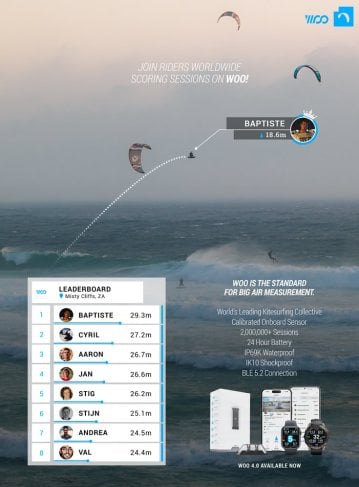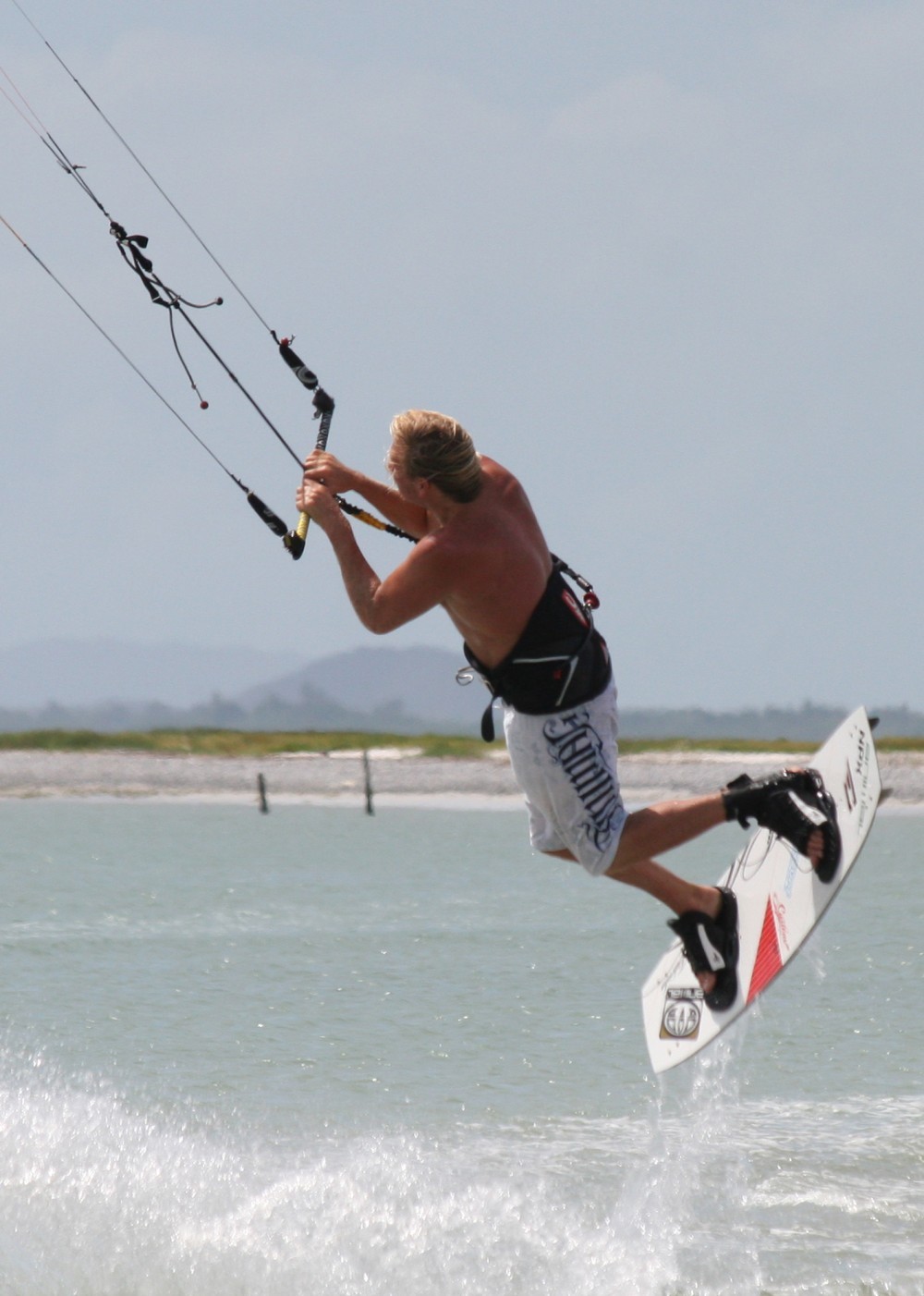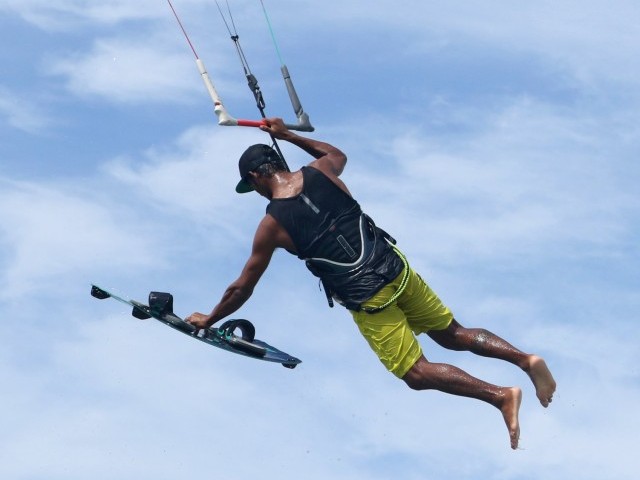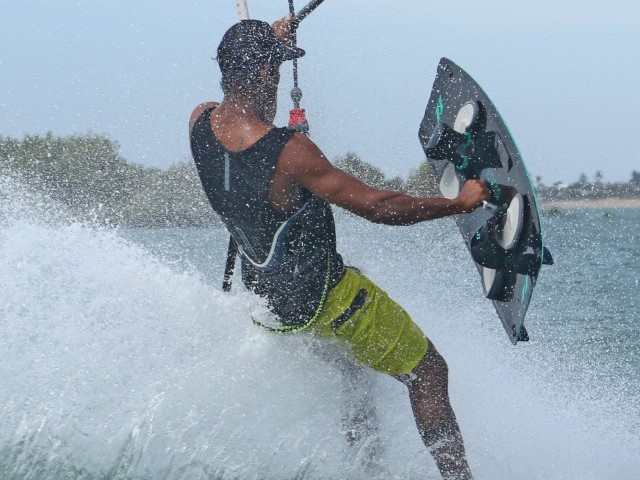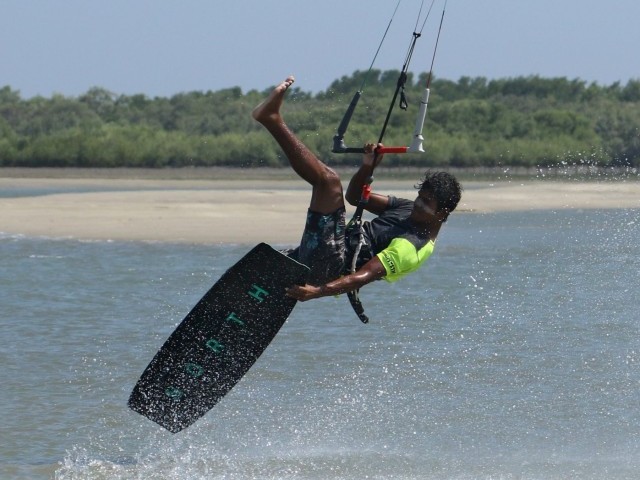
Slim Chance
Technique / Advanced
Introduction
The slim chance is one of the four base pass moves and is within reach of any aspiring freestyle nut who can pop a decent unhooked front loop. Once again as with many of these “powered” passes, it is reliant more on technique and timing than strength, so even if you don’t have the testosterone and subsequent muscles for a dangle, with practice and patience this is a realistic move for the determined among you.
So What Is It?
To over simplify the slim chance and put it in its crudest form you could say that it is an inverted front loop, which you stop half way around and then pass the bar by turning against the direction of the rotation. Or an inverted front to wrapped, or even somewhat more confusingly, but clear to some, if you can do a back to blind on starboard, it’s the same movement with a front loop on port. Have a look at the Video and the Slow Mo to get a better idea.
There are effectively two ways that people try to learn the slim. One school of thought is to do a front loop and half way around invert and do a dangle. This has two major problems: The first being that you need strength to dangle. The second being that your feet will have a habit of dropping the wrong way.
The second method, which relies on timing and pop, essentially allows you to drop over the bar and pass as you do so (hence the reference to the back to blind with an air pass). This method requires less brawn and works well both with the kite low and powered or slightly higher and therefore more forgiving. We’ll be going through this option.
Walk First
Now in preparation to learning the slim there is definitely no harm in working on your popped front loop first… You probably have a preferred way of passing the bar, which may have developed from other tricks or just from a preference in which way you turn your body. If you like passing from you right hand to your left you’ll be “slimming” on port and visa versa. Try and get your kite down to at least 11 or 1 o’clock.
Your take off is vital if you intend to get inverted. In Pic A. you can see that Christian has edged super hard and has really stamped down off his back leg, having already gone off the wind. This physical popping is vital as it allows you to keep your arms in and head up near the bar. This will enable you to throw your head down and around, whereas if your arms where extended you’ll just rotate around the axis of the lines.
Pic B. As soon as you get airborne you need to throw you head and shoulders down over and past your front foot, as this will get you feet up. You can see how Christian’s shoulders and head are moving down and forwards into the rotation. Try and get your front ear to press on your front shoulder. Because his arms are bent he is in control of the rotation. Because you’ll be releasing with your front hand the kite does have the habit of rising as you pass. You can see here that Christian is actually steering the kite down with his front hand as he throws himself into the rotation. Initially this feels wrong, but even though the mind may find it a touch rad, it is necessary.
Pic C. As he rotates Christian lifts his knees. Your aim here is to try and get your right knee towards your right hand on port, or left knee to left hand on Starboard. By doing this not only do you get inverted, but you also guarantee that you rotate far enough to land cleanly. You may also notice that Christian has not turned his head heavily into the rotation as you may normally do. If you turn you’ll spot your landing too early and come around too quickly, so try and keep your head looking forward, perpendicular with your shoulders.
Pic D. You can see how Christian’s right hip is coming towards his hands and the bar! Because the head is still going down the hips are still rising towards the hands. Your aim is to almost touch your hips and hands together as you continue to rotate.
Your aim is to get this rotation to be consistent so that you can always get inverted and so that you are aware of when your hips and hands are closing in on each other. Once you are aware, you’ll be able to anticipate the moment and pass.
Now Run
Once your comfy with the rotation and you have a feel for the timing you can add the rest. One of the most helpful tips is definitely not to rush you pass. Once you feel that you are inverted, your feet will go over and start to drop. In your head you’ll think that you missed the opportunity but this is exactly the time to go.
In Pic E. you can see Christian is inverted and his left foot is dropping, so he’ll come down the right way, as he wants to land left foot forward. He has released the bar with his left hand and is reaching around with it whilst twisting the bar into position with his right hand. As his arm reaches around, his body and head will turn back in the opposite way to the front rotation. He has helped by throwing his feet up a bit but even without extending your legs the bar will be close enough. However he has not thrown his head back as he might in a dangle, as this would throw his feet over him like a back somersault and result in a bit of a back slap as he wouldn’t turn to face his landing.
Pic F. Once you’ve made it this far it’s in the bag. You should spend a millisecond or two with both hands on the bar before the water comes into view. As your feet drop try to keep your knees bent so that your board swings under you. The first time you do this the feeling is sensational as you suddenly get your bearings and touch down to claim it.
Try walking through this on the beach, or rolling around it on the living room carpet with you legs propped up on the sofa holding a bar in your hand. This will not only help you visualise it but also get your body feeling what will be happening. If you try this on a hanging bar it’s a tad vicious on your shoulders as you swing forwards and the tree doesn’t!
Now lets follow the Sequence to get a complete feel for the slim.
Following Sequence 1
- Pic 1. Christian has unhooked and gone off the wind before carving hard with his bum low and elbows tucked in.
- Pic 2. He then pops as hard as possible up off his back leg.
- Pic 3. He throws his head and shoulders down and around, all the time keeping his head facing forwards. Christian steers the kite down with his front hand.
- Pic 4. As his head goes down, Christian brings his knees up. Elbows still in.
- Pic 5. At least half way around the rotation and Christian extends his legs and releases his front hand.
- Pic 6. He reaches around behind his back and lets his body turn to follow his arm, whilst twisting the bar into position with his back hand.
- Pic 7. Christian rotates and falls onto the bar. As his feet start to drop he looks up and spots his landing, releasing his right hand from the bar.
- Pic 8. As he drops Christian keeps his knees bent so that the board can drop underneath him.
- Pic 9. With the board underneath him Christian points it off the wind for a smooth landing.
- Pic 10. Once he’s touched down Christian reaches up to grab the bar with his free hand.
Common Problems
If you miss the bar when you pass. 99% of the time this is because the kite is too high. It’s difficult to pop hard if the kite high, and even if you do as you come around to pass the kite will be pulling the bar up and away from you. Once again if you really go for it with your pop and steer the kite down as you take off you’ll have much more chance.
If you keep coming down and landing off balance toeside, or actually rotating too far from your pass and land on your back! This is quite a typical mistake and you’ll see many folk who can slim still doing this occasionally. Try and wait longer before you pass, so that you feel that your feet are rotating into the second half of the front loop.
This could also be due to trying to dangle too much. If you really throw your hips and feet up and throw your head back you feet will drop back the way they came from, pulling you around onto you back. Another solution for this is not to try and invert too much. Just use the inversion from your take off and knees. It may not be picture perfect but it’ll work and give you confidence to go with more power.
Keystones
- Bully yourself into getting the kite low enough.
- Concentrate on popping up hard from you back leg.
- Keep your elbows tucked in.
- Ear to shoulder! Throw your head and shoulders down past your front foot.
- Wait a moment longer than you think you should before passing.
This technique article was in Issue 14 of IKSURFMAG.
Related
By Christian and Karine
Christian and Karine have been working together as a coaching team, running improver to advanced kitesurfing clinics since 2003.



